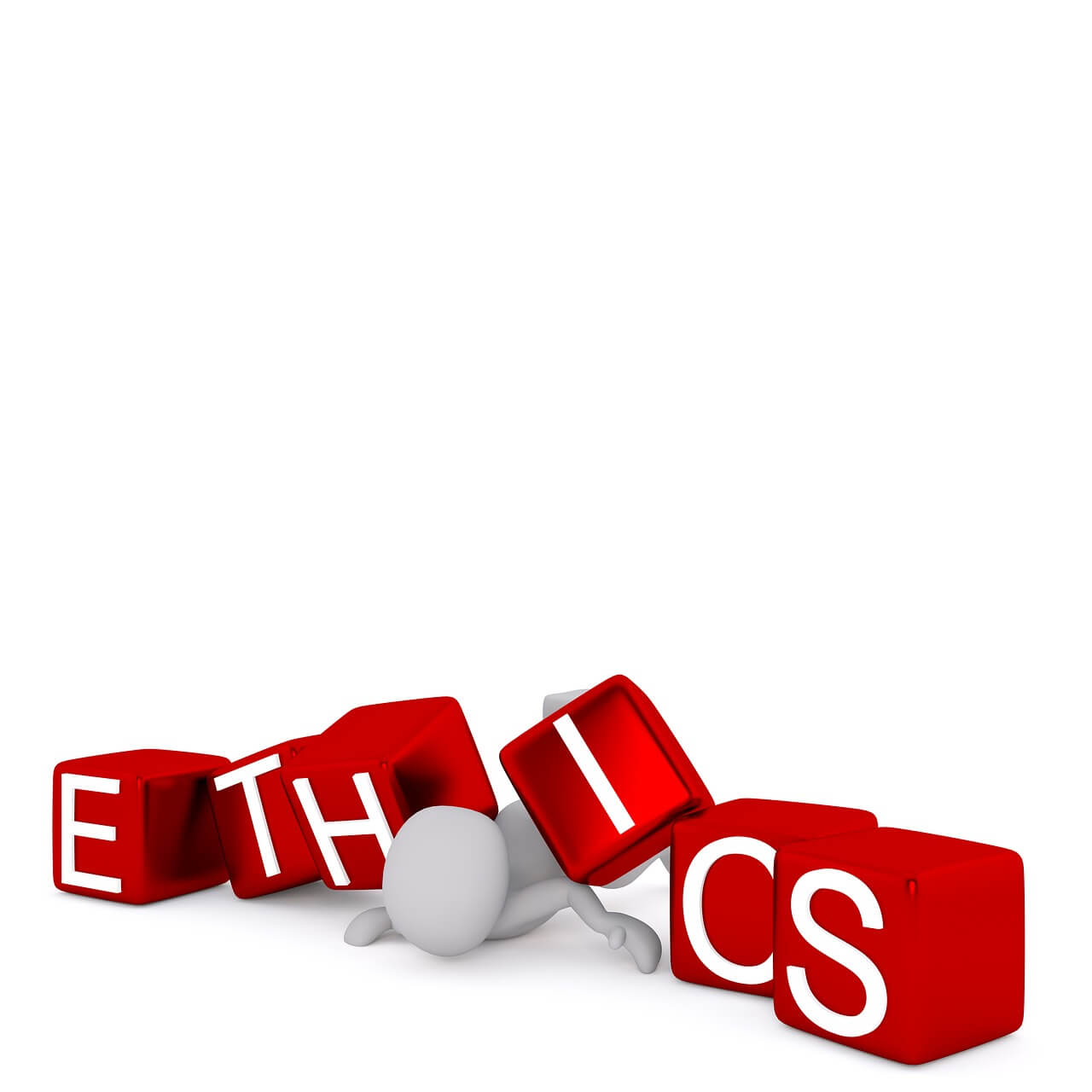© Copyright Carter McNamara, MBA, PhD, Authenticity Consulting, LLC.
(This guide is located at https://management.org/businessethics/ethics-guide.htm on the Web.)
The profession of business ethics has long needed a highly practical resource that is designed particularly for leaders and managers — those people charged with ensuring ethical practices in their organizations. Unfortunately, far too many resources about business ethics end up being designed primarily for philosophers, academics, and social critics. As a result, leaders and managers struggle to really be able to make use of the resources at all.
Also, far too many resources about business ethics contain sensationalistic stories about businesses “gone bad” or prolonged preaching to businesses to “do the right thing”. These resources often explore simplistic ethical questions, such as “Should Jane steal from the company?” The real world of leaders and managers is often much more complex than that.
This guide is a straightforward and highly practical tool designed to help leaders and managers implement comprehensive ethics management systems in their workplaces — systems to deal with the complex, ethical issues that can occur in the day-to-day realities of leading and managing an organization.
For Web readers:
This free guidebook is about 20 pages long (8 1/2″ x 11″ pages). If you are reading the document on the World Wide Web, please wait until the document is fully loaded before attempting to link to its sections listed below. The best approach to using this guidebook may be to print it out for ongoing reference. The Free Management Library provides additional information about ethics and a great range of other free information about management. For a complete list of library topics, see https://management.org/topics.htm
Disclaimer:
The author, Carter McNamara, MBA, PhD, makes no warranty, express or implied, nor assumes any legal liability for the accuracy, completeness, or usefulness of any information from this guide.
Another Tool to Effectively Infuse Ethical Principles:
If you are planning to infuse strong, ethical principles throughout your company or want to change the culture of your company, then you might take the advice of Bob Kniffin, Vice President of External Affairs, at Johnson and Johnson (J&J) company. The way that J&J handled an ethical issue (the “Tylenol scare” crisis) in the 1980s is probably one of the most inspiring and enlightening examples of how to successfully deal with a major ethical issue in business. Kniffin was one of the key players in helping J&J to handle the crisis so effectively. Kniffin said that it was not the J&J Credo (a form of a code of ethics) that helped J&J handle the crisis so well. Rather, it was the ongoing “challenge sessions” that the company regularly held in order for each person to clarify their own perspective and commitment to the J&J Credo. Authenticity Consulting’s peer coaching groups are a powerful, yet straightforward, means to organize, facilitate and evaluate challenge sessions. For more information about the peer coaching groups, go to our publications site (https://www.authenticityconsulting.com/act-lrn/AC_pubs.htm) and consider the “Program Planning Kit”.
About this Free Guidebook
· This free guidebook aims to fill a large void of practical, realistic ethics information for leaders and managers, whether nonprofit or for-profit.
· This guidebook takes about two hours to read. It is concisely written and well organized as a step-by-step guidebook for handy reference.
· This guidebook is free in order to make its contents highly accessible to organizations, particularly those with limited resources. The free nature of this document does not in any way indicate that its content is of low value — high fees and impressive presentation do not necessarily imply high value.
· The author hopes the online form of this document remains a dynamic community resource that is continually modified and improved by feedback, particularly from leaders and managers — those people in the trenches who are charged with applying business ethics techniques in the workplace.
This document contains the following sections:
- Document Fills Void of Practical Ethics Information for Leaders and Managers
- What is Business Ethics?
- 10 Myths About Business Ethics
- 10 Benefits of Managing Ethics in the Workplace
- One Description of a Highly Ethical Organization
- Ethics Management Programs: An Overview
- 8 Guidelines for Managing Ethics in the Workplace
- 6 Key Roles and Responsibilities in Ethics Management
- Ethics Tools: Codes of Ethics
- Ethics Tools: Codes of Conduct
- Ethics Tools: Policies and Procedures
- Ethics Tools: Resolving Ethical Dilemmas (with Real-to-Life Examples)
- Ethics Tools: Training
- About the Author
- Bibliography of Practical Resources
Also, consider
Related Library Topics
Acknowledgment
Particular “Thanks!” goes to Twin Cities-based consultants, Doug Wallace and Jon Pekel, of the Fulcrum Group (651-714-9033; e-mail at jonpekel@comcast.net), for contributing key information to this document. I have referenced their copyright where I included their key materials in this guidebook.
Document Fills a Void of Practical Business Ethics Information for Leaders and Managers
Current Literature is Focused on Needs of Philosophers, Academics, and Social Critics — Leaders and Managers Require More Practical Information About Managing Ethics
Managing ethics in the workplace holds tremendous benefits for leaders and managers, both moral and practical. This is particularly true today when it is critical to understand and manage highly diverse values in the workplace.
However, the field of business ethics has traditionally been the domain of philosophers, academics, and social critics. Consequently, much of today’s literature about business ethics is not geared toward the practical needs of leaders and managers — the people primarily responsible for managing ethics in the workplace. The most frequent forms of business ethics literature today typically include: a) philosophical, which requires extensive orientation and analysis; b) anthologies, which require much time, review, and integration; c) case studies, which require numerous cases, and much time and analyses to synthesize; and d) focus on social responsibility, which includes many examples of good and bad actions taken by companies. (This lack of practical information is not the fault of philosophers, academics, or social critics. The problem is the outcome of insufficient involvement of leaders and managers in discussions and literature about business ethics. More leaders and managers must become involved. This guidebook aims to increase that involvement.)
What’s Conspicuously Missing is the “How to” of Managing Ethics in the Workplace
But it isn’t for lack of examples that managers aren’t better at managing ethics in the workplace — they require more practical information about managing ethics. This problem was explained very well by Stark in his article, “What’s the Matter with Business Ethics?” published in the Harvard Business Review (1993, May/June, pp. 38-48). Brenner (Journal of Business Ethics, V11, pp. 391:399) notes “While much has been written about individual components of ethics programs, especially about codes of ethics, the literature is much more limited on ethics programs.” Wong and Beckman (Journal of Business Ethics, V11, pp. 173- 178) note that “researchers are claiming that current literature is filled with strong arguments for more ethical corporate leadership and incorporation of ethics in the business curriculum, but what is conspicuously missing is the “how to” in actually putting ethical goals and theories into practical action.”
Myths Abound About Business Ethics, e.g., “Ethics is Simply to Do What’s Right”
Lack of involvement from leaders and managers in the field of business ethics (again, this is the fault of no one or of everyone) has spawned a great deal of confusion and misunderstanding among leaders and managers about business ethics. McDonald and Zepp, in their article “What Should Be Done? A Practical Approach to Business Ethics” (Management Decision, 28, 1, 1990, pp. 9-13), note that when someone brings up the topic of business ethics “… it tends to bring up cynicism, righteousness, paranoia, and laughter.” Many leaders and managers believe business ethics is religion because it seems to contain a great deal of preaching. Or, they believe it to be superfluous because it seems to merely assert the obvious: “Do good!”
Business Ethics Literature is Often Far Too Simplistic — So Many Leaders and Managers Think Business Ethics is Irrelevant
Stark notes that “often ethicists advance a kind of moral absolutism that avoids many of the difficult and most interesting questions.” Case studies to explore ethical dilemmas are often far too simplistic, presented as if every real-life situation has a right and wrong e.g., “Should I lie, cheat or steal?” Consequently, many managers believe business ethics is irrelevant because too much business ethics training avoids the real-life complexities of leading organizations. (This document contains samples of real-to-life, complex ethical dilemmas, in a subsection, “Examples of Real-to-Life Complex Ethical Dilemmas” in the upcoming section “Ethics Tools: Resolving Ethical Dilemmas.”) Bob Dunn, President and CEO of San Francisco-based Business for Social Responsibility, explains, “Ethical decisions aren’t as easy as they used to be. Now, they’re the difference between right — and right.” Preston Townley, in his speech “Business Ethics: Commitment to Tough Decisions” (Vital Speeches, January 1992, pp. 208-211), states that “… it ought to be fairly easy to choose between right and wrong by relying on principles, but business activity often demands that we select from alternatives that are neither wholly right nor wholly wrong.”
What is Business Ethics?
Let’s Start With “What is ethics?”
Simply put, ethics involves learning what is right or wrong, and then doing the right thing — but “the right thing” is not nearly as straightforward as conveyed in a great deal of business ethics literature. Most ethical dilemmas in the workplace are not simply a matter of “Should Bob steal from Jack?” or “Should Jack lie to his boss?”
(Many ethicists assert there’s always a right thing to do based on moral principles, and others believe the right thing to do depends on the situation — ultimately it’s up to the individual.) Many philosophers consider ethics to be the “science of conduct.” Twin Cities consultants Doug Wallace and John Pekel (of the Twin Cities-based Fulcrum Group; 651-714-9033; e-mail at jonpekel@atti.com) explain that ethics includes the fundamental ground rules by which we live our lives. Philosophers have been discussing ethics for at least 2500 years, since the time of Socrates and Plato. Many ethicists consider emerging ethical beliefs to be “state of the art” legal matters, i.e., what becomes an ethical guideline today is often translated to a law, regulation, or rule tomorrow. Values that guide how we ought to behave are considered moral values, e.g., values such as respect, honesty, fairness, responsibility, etc. Statements about how these values are applied are sometimes called moral or ethical principles.
So What is “Business Ethics”?
The concept has come to mean various things to various people, but generally, it’s coming to know what it right or wrong in the workplace and doing what’s right — this is in regard to the effects of products/services and in relationships with stakeholders. Wallace and Pekel explain that attention to business ethics is critical during times of fundamental change — times much like those faced now by businesses, both nonprofit and for-profit. In times of fundamental change, values that were previously taken for granted are now strongly questioned. Many of these values are no longer followed. Consequently, there is no clear moral compass to guide leaders through complex dilemmas about what is right or wrong. Attention to ethics in the workplace sensitizes leaders and staff to how they should act. Perhaps most importantly, attention to ethics in the workplace helps ensure that when leaders and managers are struggling in times of crises and confusion, they retain a strong moral compass. However, attention to business ethics provides numerous other benefits, as well (these benefits are listed later in this document).
Note that many people react that business ethics, with its continuing attention to “doing the right thing,” only asserts the obvious (“be good,” “don’t lie,” etc.), and so these people don’t take business ethics seriously. For many of us, these principles of the obvious can go right out the door during times of stress. Consequently, business ethics can be a strong preventative medicine. Anyway, there are many other benefits of managing ethics in the workplace. These benefits are explained later in this document.
Two Broad Areas of Business Ethics
1. Managerial mischief. Madsen and Shafritz, in their book “Essentials of Business Ethics” (Penguin Books, 1990) further explain that “managerial mischief” includes “illegal, unethical, or questionable practices of individual managers or organizations, as well as the causes of such behaviors and remedies to eradicate them.” There has been a great deal written about managerial mischief, leading many to believe that business ethics is merely a matter of preaching the basics of what is right and wrong. More often, though, business ethics is a matter of dealing with dilemmas that have no clear indication of what is right or wrong.
2. Moral mazes. The other broad area of business ethics is “moral mazes of management” and includes the numerous ethical problems that managers must deal with on a daily basis, such as potential conflicts of interest, wrongful use of resources, mismanagement of contracts and agreements, etc.
Business Ethics is Now a Management Discipline
Business ethics has come to be considered a management discipline, especially since the birth of the social responsibility movement in the 1960s. In that decade, social awareness movements raised expectations of businesses to use their massive financial and social influence to address social problems such as poverty, crime, environmental protection, equal rights, public health, and improving education. An increasing number of people asserted that because businesses were making a profit from using our country’s resources, these businesses owed it to our country to work to improve society. Many researchers, business schools, and managers have recognized this broader constituency, and in their planning and operations have replaced the word “stockholder” with “stakeholder,” meaning to include employees, customers, suppliers, and the wider community.
The emergence of business ethics is similar to other management disciplines. For example, organizations realized that they needed to manage a more positive image to the public and so the recent discipline of public relations was born. Organizations realized they needed to better manage their human resources and so the recent discipline of human resources was born. As commerce became more complicated and dynamic, organizations realized they needed more guidance to ensure their dealings supported the common good and did not harm others — and so business ethics was born.
Note that 90% of business schools now provide some form of training in business ethics. Today, ethics in the workplace can be managed through the use of codes of ethics, codes of conduct, roles of ethicists and ethics committees, policies and procedures, procedures to resolve ethical dilemmas, ethics training, etc.
10 Myths About Business Ethics
Business ethics in the workplace is about prioritizing moral values for the workplace and ensuring behaviors are aligned with those values — it’s values management. Yet, myths abound about business ethics. Some of these myths arise from general confusion about the notion of ethics. Other myths arise from narrow or simplistic views of ethical dilemmas.
1. Myth: Business ethics is more a matter of religion than management.
Diane Kirrane, in “Managing Values: A Systematic Approach to Business Ethics,” (Training and Development Journal, November 1990), asserts that “altering people’s values or souls isn’t the aim of an organizational ethics program — managing values and conflict among them is …”
2. Myth: Our employees are ethical so we don’t need attention to business ethics.
Most of the ethical dilemmas faced by managers in the workplace are highly complex. Wallace explains that one knows when they have a significant ethical conflict when there is the presence of
a) significant value conflicts among differing interests, b) real alternatives that are equally justifiable, and c) significant consequences on “stakeholders” in the situation. Kirrane mentions that when the topic of business ethics comes up, people are quick to speak of the Golden Rule, honesty, and courtesy. But when presented with complex ethical dilemmas, most people realize there’s a wide “gray area” when trying to apply ethical principles.
3. Myth: Business ethics is a discipline best led by philosophers, academics, and theologians.
The lack of involvement of leaders and managers in business ethics literature and discussions has led many to believe that business ethics is a fad or movement, having little to do with the day-to-day realities of running an organization. They believe business ethics is primarily a complex philosophical debate or a religion. However, business ethics is a management discipline with a programmatic approach that includes several practical tools. Ethics management programs have practical applications in other areas of management areas, as well. (These applications are listed later on in this document.)
4. Myth: Business ethics is superfluous — it only asserts the obvious: “Do good!”
Many people react that codes of ethics, or lists of ethical values to which the organization aspires, are rather superfluous because they represent values to which everyone should naturally aspire. However, the value of a code of ethics to an organization is its priority and focus regarding certain ethical values in that workplace. For example, it’s obvious that all people should be honest. However, if an organization is struggling around continuing occasions of deceit in the workplace, a priority on honesty is very timely — and honesty should be listed in that organization’s code of ethics. Note that a code of ethics is an organic instrument that changes with the needs of society and the organization.
5. Myth: Business ethics is a matter of the good guys preaching to the bad guys.
Some writers do seem to claim a moral high ground while lamenting the poor condition of the business and its leaders. However, those people well versed in managing organizations realize that good people can take bad actions, particularly when stressed or confused. (Stress or confusion are not excuses for unethical actions — they are reasons.) Managing ethics in the workplace includes all of us working together to help each other remain ethical and to work through confusing and stressful ethical dilemmas.
6. Myth: Business ethics in the new policeperson on the block.
Many believe business ethics is a recent phenomenon because of increased attention to the topic in popular and management literature. However, business ethics was written about even 2,000 years ago — at least since Cicero wrote about the topic in his On Duties. Business ethics has gotten more attention recently because of the social responsibility movement that started in the 1960s.
7. Myth: Ethics can’t be managed.
Actually, ethics is always “managed” — but, too often, indirectly. For example, the behavior of the organization’s founder or current leader is a strong moral influence, or directive if you will, on the behavior of employees in the workplace. Strategic priorities (profit maximization, expanding market share, cutting costs, etc.) can be very strong influences on morality. Laws, regulations, and rules directly influence behaviors to be more ethical, usually in a manner that improves the general good and/or minimizes harm to the community. Some are still skeptical about business ethics, believing you can’t manage values in an organization. Donaldson and Davis (Management Decision, V28, N6) note that management, after all, is a value system. Skeptics might consider the tremendous influence of several “codes of ethics,” such as the “10 Commandments” in Christian religions or the U.S. Constitution. Codes can be very powerful in smaller “organizations” as well.
8. Myth: Business ethics and social responsibility are the same thing.
The social responsibility movement is one aspect of the overall discipline of business ethics. Madsen and Shafritz refine the definition of business ethics to be: 1) an application of ethics to the corporate community, 2) a way to determine responsibility in business dealings, 3) the identification of important business and social issues, and 4) a critique of business. Items 3 and 4 are often matters of social responsibility. (There has been a great deal of public discussion and writing about items 3 and 4. However, there needs to be more written about items 1 and 2, about how business ethics can be managed.) Writings about social responsibility often do not address practical matters of managing ethics in the workplace, e.g., developing codes, updating policies and procedures, approaches to resolving ethical dilemmas, etc.
9. Myth: Our organization is not in trouble with the law, so we’re ethical.
One can often be unethical, yet operate within the limits of the law, e.g., withhold information from superiors, fudge on budgets, constantly complain about others, etc. However, breaking the law often starts with unethical behavior that has gone unnoticed. The “boil the frog” phenomenon is a useful parable here: If you put a frog in hot water, it immediately jumps out. If you put a frog in cool water and slowly heat up the water, you can eventually boil the frog. The frog doesn’t seem to notice the adverse change in its environment.
10. Myth: Managing ethics in the workplace has little practical relevance.
Managing ethics in the workplace involves identifying and prioritizing values to guide behaviors in the organization, and establishing associated policies and procedures to ensure those behaviors are conducted. One might call this “values management.” Values management is also highly important in other management practices, e.g., managing diversity, Total Quality Management, and strategic planning.
10 Benefits of Managing Ethics in the Workplace
Many people are used to reading or hearing of the moral benefits of attention to business ethics. However, there are other types of benefits, as well. The following list describes various types of benefits of managing ethics in the workplace.
1. Attention to business ethics has substantially improved society.
A matter of decades ago, children in our country worked 16-hour days. Workers’ limbs were torn off and disabled workers were condemned to poverty and often to starvation. Trusts controlled some markets to the extent that prices were fixed and small businesses were choked out. Price fixing crippled normal market forces. Employees were terminated based on personalities. The influence was applied through intimidation and harassment. Then society reacted and demanded that businesses place a high value on fairness and equal rights. Anti-trust laws were instituted. Government agencies were established. Unions were organized. Laws and regulations were established.
2. Ethics programs help maintain a moral course in turbulent times.
As noted earlier in this document, Wallace and Pekel explain that attention to business ethics is critical during times of fundamental change — times much like those faced now by businesses, both nonprofit and for-profit. During times of change, there is often no clear moral compass to guide leaders through complex conflicts about what is right or wrong. Continuing attention to ethics in the workplace sensitizes leaders and staff to how they want to act — consistently.
3. Ethics programs cultivate strong teamwork and productivity.
Ethics programs align employee behaviors with those top-priority ethical values preferred by leaders of the organization. Usually, an organization finds a surprising disparity between its preferred values and the values actually reflected by behaviors in the workplace. Ongoing attention and dialogue regarding values in the workplace build openness, integrity, and community — critical ingredients of strong teams in the workplace. Employees feel a strong alignment between their values and those of the organization. They react with strong motivation and performance.
4. Ethics programs support employee growth and meaning.
Attention to ethics in the workplace helps employees face reality, both good and bad — in the organization and themselves. Employees feel full confidence they can admit and deal with whatever comes their way. Bennett, in his article “Unethical Behavior, Stress Appear Linked” (Wall Street Journal, April 11, 1991, p. B1), explained that a consulting company tested a range of executives and managers. Their most striking finding: the more emotionally healthy executives, as measured on a battery of tests, the more likely they were to score high on ethics tests.
5. Ethics programs are insurance policies — they help ensure that policies are legal.
There is an increasing number of lawsuits in regard to personnel matters and to effects of an organization’s services or products on stakeholders. As mentioned earlier in this document, ethical principles are often state-of-the-art legal matters. These principles are often applied to current, major ethical issues to become legislation. Attention to ethics ensures highly ethical policies and procedures in the workplace. It’s far better to incur the cost of mechanisms to ensure ethical practices now than to incur the costs of litigation later. A major intent of well-designed personnel policies is to ensure the ethical treatment of employees, e.g., in matters of hiring, evaluating, disciplining, firing, etc. Drake and Drake (California Management Review, V16, pp. 107-123) note that “an employer can be subject to suit for breach of contract for failure to comply with any promise it made, so the gap between stated corporate culture and actual practice has significant legal, as well as ethical implications.”
6. Ethics programs help avoid criminal acts “of omission” and can lower fines.
Ethics programs tend to detect ethical issues and violations early on so they can be reported or addressed. In some cases, when an organization is aware of an actual or potential violation and does not report it to the appropriate authorities, this can be considered a criminal act, e.g., in business dealings with certain government agencies, such as the Defense Department. The recent Federal Sentencing Guidelines specify major penalties for various types of major ethics violations. However, the guidelines potentially lower fines if an organization has clearly made an effort to operate ethically.
7. Ethics programs help manage values associated with quality management, strategic planning, and diversity management — this benefit needs far more attention.
Ethics programs identify preferred values and ensure organizational behaviors are aligned with those values. This effort includes recording the values, developing policies and procedures to align behaviors with preferred values, and then training all personnel about the policies and procedures. This overall effort is very useful for several other programs in the workplace that require behaviors to be aligned with values, including quality management, strategic planning, and diversity management. Total Quality Management includes high priority on certain operating values, e.g., trust among stakeholders, performance, reliability, measurement, and feedback. Eastman and Polaroid use ethics tools in their quality programs to ensure integrity in their relationships with stakeholders. Ethics management techniques are highly useful for managing strategic values, e.g., expanding market share, reducing costs, etc. McDonnell Douglas integrates their ethics programs into their strategic planning process. Ethics management programs are also useful in managing diversity. Diversity is much more than the color of people’s skin — it’s acknowledging different values and perspectives. Diversity programs require recognizing and applying diverse values and perspectives — these activities are the basis of a sound ethics management program.
8. Ethics programs promote a strong public image.
Attention to ethics is also strong in public relations — admittedly, managing ethics should not be done primarily for reasons of public relations. But, frankly, the fact that an organization regularly gives attention to its ethics can portray a strong positive to the public. People see those organizations as valuing people more than profit, as striving to operate with the utmost integrity and honor. Aligning behavior with values is critical to effective marketing and public relations programs. Consider how Johnson and Johnson handled the Tylenol crisis versus how Exxon handled the oil spill in Alaska. Bob Dunn, President and CEO of San Francisco-based Business for Social Responsibility, puts it best: “Ethical values, consistently applied, are the cornerstones in building a commercially successful and socially responsible business.”
9. Overall benefits of ethics programs:
Donaldson and Davis, in “Business Ethics? Yes, But What Can it Do for the Bottom Line?” (Management Decision, V28, N6, 1990) explain that managing ethical values in the workplace legitimizes managerial actions, strengthens the coherence and balance of the organization’s culture, improves trust in relationships between individuals and groups, supports greater consistency in standards and qualities of products, and cultivates greater sensitivity to the impact of the enterprise’s values and messages.
10. Last – and most — formal attention to ethics in the workplace is the right thing to do.
One Description of a Highly Ethical Organization
Mark Pastin, in The Hard Problems of Management: Gaining the Ethics Edge (Jossey-Bass, 1986), provides the following four principles for highly ethical organizations:
1. They are at ease interacting with diverse internal and external stakeholder groups. The ground rules of these firms make the good of these stakeholder groups part of the organizations’ own good.
2. They are obsessed with fairness. Their ground rules emphasize that the other person’s interests count as much as their own.
3. Responsibility is individual rather than collective, with individuals assuming personal responsibility for the actions of the organization. These organizations’ ground rules mandate that individuals are responsible for themselves.
4. They see their activities in terms of purpose. This purpose is a way of operating that members of the organization highly value. Purpose ties the organization to its environment.
Doug Wallace asserts the following characteristics of a high-integrity organization:
1. There exists a clear vision and picture of integrity throughout the organization.
2. The vision is owned and embodied by top management, over time.
3. The reward system is aligned with the vision of integrity.
4. Policies and practices of the organization are aligned with the vision; no mixed messages.
5. It is understood that every significant management decision has ethical value dimensions.
6. Everyone is expected to work through conflicting stakeholder value perspectives.
Ethics Management Programs: An Overview
About Ethics Management Programs Organizations can manage ethics in their workplaces by establishing an ethics management program. Brian Schrag, Executive Secretary of the Association for Practical and Professional Ethics, clarifies. “Typically, ethics programs convey corporate values, often using codes and policies to guide decisions and behavior, and can include extensive training and evaluating, depending on the organization. They provide guidance in ethical dilemmas.” Rarely are two programs alike.
“All organizations have ethics programs, but most do not know that they do,” wrote business ethics professor Stephen Brenner in the Journal of Business Ethics (1992, V11, pp. 391-399). “A corporate ethics program is made up of values, policies, and activities which impact the propriety of organization behaviors.”
Bob Dunn, President and CEO of San Francisco-based Business for Social Responsibility, adds: “Balancing competing values and reconciling them is a basic purpose of an ethics management program. Business people need more practical tools and information to understand their values and how to manage them.”
Benefits of Managing Ethics as a Program
There are numerous benefits in formally managing ethics as a program, rather than as a one-shot effort when it appears to be needed. Ethics programs:
· Establish organizational roles to manage ethics
· Schedule an ongoing assessment of ethics requirements
· Establish required operating values and behaviors
· Align organizational behaviors with operating values
· Develop awareness and sensitivity to ethical issues
· Integrate ethical guidelines into decision making
· Structure mechanisms to resolving ethical dilemmas
· Facilitate ongoing evaluation and updates to the program
· Help convince employees that attention to ethics is not just a knee-jerk reaction done to get out of trouble or improve the public image
8 Guidelines for Managing Ethics in the Workplace
The following guidelines ensure the ethics management program is operated in a meaningful fashion:
1. Recognize that managing ethics is a process.
Ethics is a matter of values and associated behaviors. Values are discerned through the process of ongoing reflection. Therefore, ethics programs may seem more process-oriented than most management practices. Managers tend to be skeptical of process-oriented activities and instead prefer processes focused on deliverables with measurements. However, experienced managers realize that the deliverables of standard management practices (planning, organizing, motivating, controlling) are only tangible representations of very process-oriented practices. For example, the process of strategic planning is much more important than the plan produced by the process. The same is true for ethics management. Ethics programs do produce deliverables, e.g., codes, policies and procedures, budget items, meeting minutes, authorization forms, newsletters, etc. However, the most important aspect of an ethics management program is the process of reflection and dialogue that produces these deliverables.
2. The bottom line of an ethics program is accomplishing preferred behaviors in the workplace.
As with any management practice, the most important outcome is behaviors preferred by the organization. The best ethical values and intentions are relatively meaningless unless they generate fair and just behaviors in the workplace. That’s why practices that generate lists of ethical values, or codes of ethics, must also generate policies, procedures, and training that translate those values to appropriate behaviors.
3. The best way to handle ethical dilemmas is to avoid their occurrence in the first place.
That’s why practices such as developing codes of ethics and codes of conduct are so important. Their development sensitizes employees to ethical considerations and minimizes the chances of unethical behavior occurring in the first place.
4. Make ethical decisions in groups, and make decisions public, as appropriate.
This usually produces better quality decisions by including diverse interests and perspectives and increases the credibility of the decision process and outcome by reducing suspicion of unfair bias.
5. Integrate ethics management with other management practices.
When developing the values statement during strategic planning, include ethical values preferred in the workplace. When developing personnel policies, reflect on what ethical values you’d like to be most prominent in the organization’s culture and then design policies to produce these behaviors.
6. Use cross-functional teams when developing and implementing the ethics management program.
It’s vital that the organization’s employees feel a sense of participation and ownership in the program if they are to adhere to its ethical values. Therefore, include employees in developing and operating the program.
7. Value forgiveness.
This may sound rather religious or preachy to some, but it’s probably the most important component of any management practice. An ethics management program may at first actually increase the number of ethical issues to be dealt with because people are more sensitive to their occurrence. Consequently, there may be more occasions to address people’s unethical behavior. The most important ingredient for remaining ethical is trying to be ethical. Therefore, helps people recognize and address their mistakes and then supports them to continue to try to operate ethically.
8. Note that trying to operate ethically and making a few mistakes is better than not trying at all.
Some organizations have become widely known for operating in a highly ethical manner, e.g., Ben and Jerry’s, Johnson and Johnson, Aveda, Hewlett Packard, etc. Unfortunately, it seems that when an organization achieves this strong public image, it’s placed on a pedestal by some business ethics writers. All organizations are comprised of people and people are not perfect. However, when a mistake is made by any of these organizations, the organization has a long way to go. In our increasingly critical society, these organizations are accused of being hypocritical and they are soon pilloried by social critics. Consequently, some leaders may fear sticking their necks out publicly to announce an ethics management program. This is extremely unfortunate. It’s the trying that counts and brings peace of mind — not achieving a heroic status in society.
6 Key Roles and Responsibilities in Ethics Management
Depending on the size of the organization, certain roles may prove useful in managing ethics in the workplace. These can be full-time roles or part-time functions assumed by someone already in the organization. Small organizations certainly will not have the resources to implement each of the following roles using different people in the organization. However, the following functions point out responsibilities that should be included somewhere in the organization.
1. The organization’s chief executive must fully support the program.
If the chief executive isn’t fully behind the program, employees will certainly notice — and this apparent hypocrisy may cause such cynicism that the organization may be worse off than having no formal ethics program at all. Therefore, the chief executive should announce the program, and champion its development and implementation. Most importantly, the chief executive should consistently aspire to lead in an ethical manner. If a mistake is made, admit it.
2. Consider establishing an ethics committee at the board level.
The committee would be charged to oversee the development and operation of the ethics management program.
3. Consider establishing an ethics management committee.
It would be charged with implementing and administrating an ethics management program, including administrating and training about policies and procedures, and resolving ethical dilemmas. The committee should be comprised of senior officers.
4. Consider assigning/developing an ethics officer.
This role is becoming more common, particularly in larger and more progressive organizations. The ethics officer is usually trained about matters of ethics in the workplace, particularly in resolving ethical dilemmas.
5. Consider establishing an ombudsperson.
The Ombudsperson is responsible for helping coordinate the development of the policies and procedures to institutionalize moral values in the workplace. This position usually is directly responsible for resolving ethical dilemmas by interpreting policies and procedures.
6. Note that one person must ultimately be responsible for managing the ethics management program.
Ethics Tools: Codes of Ethics
About Codes of Ethics
According to Wallace, “A credo generally describes the highest values to which the company aspires to operate. It contains the `thou shalt.’ A code of ethics specifies the ethical rules of operation. It’s the `thou shalt nots.” In the latter 1980s, The Conference Board, a leading business membership organization, found that 76% of corporations surveyed had codes of ethics.
Some business ethicists disagree that codes have any value. Usually, they explain that too much focus is put on the codes themselves, and that codes themselves are not influential in managing ethics in the workplace. Many ethicists note that it’s the developing and continuing dialogue around the code’s values that is most important.
Occasionally, employees react to codes with suspicion, believing the values are “motherhood and apple pie” and codes are for window dressing. But, when managing a complex issue, especially in a crisis, having a code is critical. More important, it’s having developed a code. In the mid-70s, Johnson and Johnson updated their credo in a series of challenge meetings. Bob Kniffin, Vice President of External Affairs, explains, “We pored over each phrase and word. We asked ourselves, `Do we still believe this?’ Our meetings resulted in some fine-tuning, but basically, we didn’t change the values. The meetings infused the values in the minds of all of us managers.” Many believe this process guided them in their well-known decision to pull Tylenol bottles off the shelves and repackage them at a $100 million expense. Kniffin offers some sound, practical advice. “In a crisis, there’s no time for moral conclusions. Get those done beforehand. But also realize there’s no substitute for sound crisis management. For example, have a list of people with fundamental knowledge, such as who transports your products where and when.”
Developing Codes of Ethics
Note that if your organization is quite large, e.g., includes several large programs or departments, you may want to develop an overall corporate code of ethics and then a separate code to guide each of your programs or departments.
Also note that codes should not be developed out of the Human Resources or Legal departments alone, as is too often done. Codes are insufficient if intended only to ensure that policies are legal. All staff must see the ethics program being driven by top management.
Note that codes of ethics and codes of conduct may be the same in some organizations, depending on the organization’s culture and operations and on the ultimate level of specificity in the code(s).
Optional: Also see the Free Management Library at https://management.org:
1. Organizational Culture – review to get a basic understanding of the “personalities” of organizations
2. Strategic Planning – specific to developing a Values Statement
3. Diversity and Inclusion– to consider that there are other values and perspectives
Consider the following guidelines when developing codes of ethics:
1. Review any values needed to adhere to relevant laws and regulations;
this ensures your organization is not (or is not near) breaking any of them. (If you are breaking any of them, you may be far better off to report this violation than to try to hide the problem. Often, a reported violation generates more leniency than outside detection of an unreported violation, particularly per the new Federal Sentencing Guidelines.) Increase priority on values that will help your organization operate to avoid breaking these laws and to follow necessary regulations.
2. Review which values produce the top three or four traits of a highly ethical and successful product or service in your area,
e.g., for accountants: objectivity, confidentiality, accuracy, etc. Identify which values produce behaviors that exhibit these traits.
3. Identify the values needed to address current issues in your workplace.
Appoint one or two key people to interview key staff to collect descriptions of major issues in the workplace. Collect descriptions of behaviors that produce the issues. Consider which of these issues is ethical in nature, e.g….., issues in regard to respect, fairness, and honesty. Identify the behaviors needed to resolve these issues. Identify which values would generate those preferred behaviors. There may be values included here that some people would not deem as moral or ethical values, e.g., team-building and promptness, but for managers, these practical values may add more relevance and utility to a code of ethics.
4. Identify any values needed, based on findings during strategic planning.
Review information from your SWOT analysis (identifying the organization’s strengths, weaknesses, opportunities, and threats). What behaviors are needed to build on strengths, shore up weaknesses, take advantage of opportunities, and guard against threats?
5. Consider any top ethical values that might be prized by stakeholders.
For example, consider the expectations of employees, clients/customers, suppliers, funders, members of the local community, etc.
6. Collect from the above steps, the top five to ten ethical values which are high priorities in your organization (see item #7 below for examples).
7. Examples of ethical values might include
(the following list is the “Six Pillars of Character” developed by The Josephson Institute of Ethics, 310-306-1868):
a) Trustworthiness: honesty, integrity, promise-keeping, loyalty
b) Respect: autonomy, privacy, dignity, courtesy, tolerance, acceptance
c) Responsibility: accountability, the pursuit of excellence
d) Caring: compassion, consideration, giving, sharing, kindness, loving
e) Justice and fairness: procedural fairness, impartiality, consistency, equity, equality, due process
f) Civic virtue and citizenship: law-abiding, community service, protection of the environment
8. Compose your code of ethics; attempt to associate with each value, two example behaviors that reflect each value.
Critics of codes of ethics assert that they seem vacuous because many only list ethical values and don’t clarify these values by associating examples of behaviors.
9. Include wording that indicates all employees are expected to conform to the values stated in the code of ethics.
Add wording that indicates where employees can go if they have any questions.
10. Obtain review from key members of the organization.
Get input from as many members as possible.
11. Announce and distribute the new code of ethics (unless you are waiting to announce it along with any new codes of conduct and associated policies and procedures).
Ensure each employee has a copy and postcodes throughout the facility.
12. Update the code at least once a year.
As stated several times in this document, the most important aspect of codes is developing them, not the code itself. Continued dialogue and reflection around ethical values produce ethical sensitivity and consensus. Therefore, revisit your codes at least once a year — preferably two or three times a year.
13. (Note that you cannot include values and preferred behaviors for every possible ethical dilemma that might arise.
Your goal is to focus on the top ethical values needed in your organization and to avoid potential ethical dilemmas that seem most likely to occur.)
Ethics Tools: Codes of Conduct
About Codes of Conduct
“Codes of conduct specify actions in the workplace and codes of ethics are general guides to decisions about those actions,” explains Craig Nordlund, Associate General Counsel and Secretary at Hewlett Packard. He suggests that codes of conduct contain examples of appropriate behavior to be meaningful.
The Conference Board found that codes of conduct are increasingly sophisticated and focused at lower levels in companies. Departments frequently have their own codes. Be careful, though. An organization
could be sued for breach of contract if its practices are not in accordance with its policies. That’s why legal departments should review codes of conduct and other ethics policies. Also, that’s why it’s critical for organizations to review their policies at least once a year to ensure they are in accordance with laws and regulations.
Optional: also see the Free Management Library at https://management.org:
1. Employee Law – review major issues and topics to discern what behaviors to avoid in the workplace
2. Policies (Personnel) – review more specifics about what behaviors to avoid
Developing a Code of Conduct
Note that if your organization is quite large, e.g., includes several large programs or departments, you may want to develop an overall corporate code of conduct, and then a separate code to guide each of your programs or departments. Consider the following guidelines when developing codes of conduct:
1. Identify key behaviors needed to adhere to the ethical values proclaimed in your code of ethics, including ethical values derived from a review of key laws and regulations, ethical behaviors needed in your product or service area, behaviors to address current issues in your workplace, and behaviors needed to reach strategic goals.
2. Include wording that indicates all employees are expected to conform to the behaviors specified in the code of conduct.
Add wording that indicates where employees can go if they have any questions.
3. Obtain review from key members of the organization.
Be sure your legal department reviews the drafted code of conduct.
4. Announce and distribute the new code of conduct
(unless you are waiting to announce it along with any associated policies and procedures). Ensure each employee has a copy and postcodes in each employee’s bay or office.
5. (Note that you cannot include preferred behaviors for every possible ethical dilemma that might arise.)
6. Examples of topics typically addressed by codes of conduct include:
preferred style of dress, avoiding illegal drugs, following instructions of superiors, being reliable and prompt, maintaining confidentiality, not accepting personal gifts from stakeholders as a result of company role, avoiding racial or sexual discrimination, avoiding conflict of interest, complying with laws and regulations, not using organization’s property for personal use, not discriminating against race or age or sexual orientation, and reporting illegal or questionable activity. Go beyond these traditional legalistic expectations in your codes — adhere to what’s ethically sensitive in your organization, as well. (Note that, as with codes of ethics, you may be better off generating your own code of conduct from scratch rather than reviewing examples from other organizations.)
Ethics Tools: Policies and Procedures
Optional: also see the Free Management Library at https://management.org:
Policies (Personnel) – review to understand how to develop and apply personnel policies
1. Update policies and procedures to produce behaviors preferred by the code of conduct,
including, e.g., personnel, job descriptions, performance appraisal forms, management-by-objectives expectations, standard forms, checklists, budget report formats, and other relevant control instruments to ensure conformance to the code of conduct. In doing so, try to avoid creating ethical dilemmas such as conflicts of interest or infringing on employees’ individual rights.
2. There are numerous examples of how organizations manage values through the use of policies and procedures.
For example, we’re most familiar with the value of social responsibility. To produce behavior aligned with this value, organizations often institute policies such as recycling waste, donating to local charities, or paying employees to participate in community events. In another example, a high value on responsiveness to customers might be implemented by instituting policies to return phone calls or to repair defective equipment within a certain period of time. Consider the role of job descriptions and performance appraisals. For example, an advanced technology business will highly value technical knowledge, creativity, and systems thinking. They use job descriptions and performance appraisals to encourage behaviors aligned with these values, such as rewarding advanced degrees, patents, and analysis and design skills.
3. Include policies and procedures to address ethical dilemmas.
See the next section, “Ethics Tools: Resolving Ethical Dilemmas,” to select a method that is most appropriate to your organization’s culture and operations.
4. Include policies and procedures to ensure the training of employees about the ethics management program.
See the following section, “Ethics Tools: Training.”
5. Include policies and procedures to reward ethical behavior and impose consequences for unethical behavior.
6. Include a grievance policy for employees to use to resolve disagreements with supervisors and staff.
7. Consider establishing an ethics “hotline.”
This function might best be provided by an outside consultant, e.g., a lawyer, a clergyperson, etc. Or, provide an anonymous “tip” box in which personnel can report suspected unethical activities, and do so safely on an anonymous basis.
8. Once a year, review all personnel policies and procedures.
If yours is a small organization, consider including all staff during this review. Take a full day for all staff to review policies and procedures, and suggest changes.
9. For guidance in establishing personnel policies, see the
Guide to Personnel Management and Policies (https://management.org/management/guidebook.htm).
Ethics Tools: Resolving Ethical Dilemmas (with Real-to-Life
Examples)
Definition of an Ethical Dilemma
Perhaps too often, business ethics is portrayed as a matter of resolving conflicts in which one option appears to be a clear choice. For example, case studies are often presented in which an employee is faced with whether or not to lie, steal, cheat, abuse another, break the terms of a contract, etc. However, ethical dilemmas faced by managers are often more real-to-life and highly complex with no clear guidelines, whether in law or often in religion.
As noted earlier in this document, Doug Wallace, a Twin Cities-based consultant, explains that one knows when they have a significant ethical conflict when there is the presence of a) significant value conflicts among differing interests, b) real alternatives that are equality justifiable, and c) significant consequences on “stakeholders” in the situation.
An ethical dilemma exists when one is faced with having to make a choice among these alternatives.
Real-to-Life Examples of Complex Ethical Dilemmas
· “A customer (or client) asked for a product (or service) from us today. After telling him our price, he said he couldn’t afford it. I know he could get it cheaper from a competitor. Should I tell him about the competitor — or let him go without getting what he needs? What should I do?”
· “Our company prides itself on its merit-based pay system. One of my employees has done a tremendous job all year, so he deserves strong recognition. However, he’s already paid at the top of the salary range for his job grade and our company has too many people in the grade above him, so we can’t promote him. What should I do?”
· “Our company prides itself on hiring minorities. One Asian candidate fully fits the job requirements for our open position. However, we’re concerned that our customers won’t understand his limited command of the English language. What should I do?”
· “My top software designer suddenly refused to use our e-mail system. He explained to me that, as a Christian, he could not use a product built by a company that provided benefits to the partners of homosexual employees. He’d basically cut himself off from our team, creating a major obstacle to our product development. What should I do?”
· “My boss told me that one of my employees is among several others to be laid off soon and that I’m not to tell my employee yet or he might tell the whole organization which would soon be in an uproar. Meanwhile, I heard from my employee that he plans to buy braces for his daughter and a new carpet for his house. What should I do?”
· “My computer operator told me he’d noticed several personal letters printed from a computer that I was responsible for managing. While we had no specific policies then against personal use of company facilities, I was concerned. I approached the letter writer to discuss the situation. She told me she’d written the letters on her own time to practice using our word processor. What should I do?”
· “A fellow employee told me that he plans to quit the company in two months and start a new job which has been guaranteed to him. Meanwhile, my boss told me that he wasn’t going to give me a new opportunity in our company because he was going to give it to my fellow employee. What should I do?”
Optional: also see the Free Management Library at https://management.org:
1. Feedback
2. Listening
3. Questioning
4. Conflict (interpersonal)
5. Negotiating
6. Diversity and Inclusion Diversity and Inclusion
3 Methods to Resolve Ethical Dilemmas
Organizations should develop and document a procedure for dealing with ethical dilemmas as they arise. Ideally, ethical dilemmas should be resolved by a group within the organization, e.g., an ethics committee comprised of top leaders/managers and/or members of the board. Consider having staff members on the committee, as well. The following three methods can be used to address ethical dilemmas. Methods include an ethical checklist, a ten-step method, and a list of key questions. (Note that The Golden Rule is probably the most common method to resolve ethical dilemmas. The rule exists in various forms in many of the world religions.)
Method One – Ethical Checklist
Twin Cities-based consultants, Doug Wallace, and Jon Pekel, suggest the following ethical checklist to address ethical dilemmas. If necessary, revise your decision and action plan based on results of the this test.
NOTE: To get the longer version of this document, see
Ten-Step Method for Ethical Decision-Making
| Ethical Checklist | Circle the appropriate answer on the scale; “1” = not at all; “5” = totally yes | |||||||
| 1. | Relevant Information Test. Have I/we obtained as much information as possible to make an informed decision and action plan for this situation? | 1 | 2 | 3 | 4 | 5 | ||
| 2. | Involvement Test. Have I/we involved all who have a right to have input and/or to be involved in making this decision and action plan? | 1 | 2 | 3 | 4 | 5 | ||
| 3. | Consequential Test. Have I/we anticipated and attempted to accommodate for the consequences of this decision and action plan on any who are significantly affected by it? | 1 | 2 | 3 | 4 | 5 | ||
| 4. | Fairness Test. If I/we were assigned to take the place of any one of the stakeholders in this situation, would I/we perceive this decision and action plan to be essentially fair, given all of the circumstances? | 1 | 2 | 3 | 4 | 5 | ||
| 5. | Enduring Values Test. Does this decision and action plan uphold my/our priority enduring values that are relevant to this situation? | 1 | 2 | 3 | 4 | 5 | ||
| 6. | Universality Test. Would I/we want this decision and action plan to become a universal law applicable to all similar situations, even to myself/ourselves? | 1 | 2 | 3 | 4 | 5 | ||
| 7. | Light-of-Day Test. How would I/we feel and be regarded by others (working associates, family, etc.) if the details of this decision and action plan were disclosed for all to know? | 1 | 2 | 3 | 4 | 5 | ||
| 8. | Total Ethical Analysis Confidence Score. Place the total of all circled numbers here. | |||||||
| How confident can you be that you have done a good job of ethical analysis? | ||||||||
| 7-14 15-21 22-28 29-35 |
Not very confident Somewhat confident Quite confident Very confident |
|||||||
Used with permission from Copyright holders: Doug Wallace and Jon Pekel, Twin Cities-based consultants in the Fulcrum Group (651-714-9033; e-mail at jonpekel@atti.com). Do not copy without reference to copyright owners. Not to be used for commercial purposes.
Method Two – Ten-Step Method of Decision Making
Wallace and Pekel also provide the following ten-step method.
10-Step Method (Short Version)
Used with permission from Copyright holders: Doug Wallace and Jon Pekel, Twin Cities-based consultants in the Fulcrum Group (651-714-9033; e-mail at jonpekel@comcast.net). Do not copy without reference to copyright owners. Not to be used for commercial purposes.
Method Three – Twelve Questions to Address Ethical Dilemmas
Laura L. Nash poses 12 questions to help managers address ethical dilemmas.
1. Have you defined the problem accurately?
2. How would you define the problem if you stood on the other side of the fence?
3. How did this situation occur in the first place?
4. To whom and to whom do you give your loyalty as a person and as a member of the corporation?
5. What is your intention in making this decision?
6. How does this intention compare with the probable results?
7. Whom could your decision or action injure?
8. Can you discuss the problem with the affected parties before you make your decision?
9. Are you confident that your position will be as valid over
a long period of time as it seems now?
10. Could you disclose without qualm your decision or action to your boss, your CEO, the board of directors, your family, and society as a whole?
11. What is the symbolic potential of your action if understood? misunderstood?
12. Under what conditions would you allow exceptions to your stand?
(adapted from: Nash, L. (1981). Ethics Without the Sermon. Harvard Business Review, (59))
Ethics Tools: Training
The ethics program is essentially useless unless all staff members are trained about what it is, how it works, and their roles in it. The nature of the system may invite suspicion if not handled openly and honestly. In addition, no matter how fair and up-to-date is a set of policies, the legal system will often interpret employee behavior (rather than written policies) as de facto policy. Therefore, all staff must be aware of and act in full accordance with policies and procedures (this is true, whether policies and procedures are for ethics programs or personnel management). This full accordance requires training about policies and procedures.
Optional: Also see the Free Management Library at https://management.org
Training Basics for Supervisors and Learners
1. Orient new employees to the organization’s ethics program during new-employee orientation.
2. Review the ethics management program in management training experiences.
3. Involving staff in the review of codes is strong ethics training.
4. Involving staff in the review of policies (ethics and personnel policies) is strong ethics training.
5. One of the strongest forms of ethics training is the practice of resolving complex ethical dilemmas. Have staff use any of the three ethical-dilemma-resolution methods in this guidebook and apply them to any of the real-to-life ethical dilemmas also listed in this guidebook.
6. Include ethical performance as a dimension in performance appraisals.
7. The best ethics trainer: Bill Goodman, Chief Human Resource Officer at Aveda, describes, “We start our training even in our job ads,” then adds, “but the best trainer is the behavior of our leaders.”
8. Give all staff a copy of this free “Complete Guide to Ethics Management.”
About the Author
Carter McNamara, MBA, Ph.D., is a Twin Cities-based consultant in the areas of leadership development, board development, and strategic planning. He has managed a wide variety of organizations including startups, public-private, small and large nonprofits, and large corporations. He received comprehensive ethics training as an employee in a large defense contractor, various ethics classes, and continuing research in business ethics. In addition, as a manager, he has struggled through several major ethical dilemmas (one was quite public) so he knows and understands the experience. He has led the development of several codes of ethics and conduct, as well. Carter holds a BA in Social and Behavioral Sciences, a BS in Computer Science, an MBA, and a Ph.D. in Human and Organization Development.
Bibliography of Practical Resources
Hardcopy documents:
The following references are to hardcopy documents that provide information about managing ethics in the workplace:
Berenbeim, R. E. (1992, Spring). “The Corporate Ethics Test”. Business and Society Review, 31(1), 77-80.
Brenner, S. N. (1992). “Ethics Programs and Their Dimensions”. Journal of Business Ethics, 11,391-399.
Buchholz, R. A. (1989). “Fundamental Concepts and Problems in Business Ethics”. In Madsen, P., & Shafritz, J. M. (Eds.) (1990). “Essentials of Business Ethics”. New York: Penguin Books.
Carroll, A. B. (1990). “Principles of Business Ethics: Their Role in Decision Making and in Initial Consensus”.
Management Decision, 28(8), 21-23.
Dean, P. J. (1992). “Making Codes of Ethics ‘Real’.” Journal of Business Ethics, 11, 285-290.
Deborah, B. (1991, January/February). “Asking for Help: A Guide to Using Socially Responsible Consultants”. Business Ethics Magazine, pp. 24-29.
Francis, David R. (1991, June). “Prevent Trouble by Improving Ethics”. Christian Science Monitor, p. 9.
Fulcrum Consulting Group, 1093 Snelling Ave. South, Saint Paul, MN 55116. Phone 1-800-55-ETHIC.
Gandz, J. & Bird, F. G. (1989, Autumn). “Designing Ethical Organizations”. Business Quarterly, 54(2), 108-112.
Genfan, H. (1987, November). “Formalizing Business Ethics”. Training and Development Journal, pp. 35-37.
Josephson Institute of Ethics, 310 Washington Boulevard, Suite 104, Marina del Rey, California. Phone 310-306-1868.
Kirrane, D.E. (1990, November). “Managing Values: A Systematic Approach to Business Ethics”. Training and Development Journal, pp. 53-60.
Madsen, P., Ph. D., & Shafritz, J. M., Ph. D. (Eds.). (1990). “Essentials of Business Ethics”. New York: Penguin Books.
McDonald, G., & Zepp, R. (1990). “What Should Be Done? A Practical Approach to Business Ethics”. Management Decision, 28(1), 9-13.
Nash, L. (1981). “Ethics Without the Sermon”. Harvard Business Review, (59).
Navran Associates Management Consultants, 3037 Wembley Ridge, Atlanta, GA. Phone 404-493-8886.
Reynolds, L. (1992, July/August). “The Ethics Audit. Business Ethics Magazine”, pp. 20-22.
Sims, R. R. (1991). “Institutionalization of Organizational Ethics”. Journal of Business Ethics, 10, 493-506.
Strong, K. C., & Meyer, G. (1992). “An Integrative Descriptive Model of Ethics Decision Making”. Journal of Business Ethics, 11, 89-94.
Thompson, T. (1991, Spring). “Managing Business Ethics”. Canadian Public Administration, 34(1), 153-157.
Toffler, B. (1991, Winter). “Doing Ethics: An Approach to Business Ethics Consulting”. Moral Education Forum, 16(4), 14-20.
World Wide Web Links:
The following are links to Websites about business ethics.
General business ethics resources at the Center for Applied Ethics (http://www.ethics.ubc.ca/resources/business/)
Center for Applied Ethics at http://www.ethics.ubc.ca/
For the Category of Ethics:
To round out your knowledge of this Library topic, you may want to review some related topics, available from the link below. Each of the related topics includes free, online resources.
Also, scan the Recommended Books listed below. They have been selected for their relevance and highly practical nature.
 Sections of this topic
Sections of this topic
















